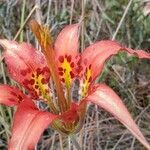Bulbs ovoid, 1.6–2.5 × 1.3–2.4 cm, 0.8–1.6 times taller than long, 2 years’ growth evident, newer bearing prominent basal leaves, older with abscission scars; scales few, loose, unsegmented or 2-segmented, longest 1–1.8 cm; stem roots usually present, often numerous. Stems to 0.9 m. Buds rounded in cross section. Leaves scattered, ascending, distal appressed, 1.8–8.2 × 0.2–1.2 cm, 3.1–10.5 times longer than wide; blade narrowly elliptic, sometimes linear or slightly oblanceolate, margins not undulate, apex acute, acuminate especially in distal leaves; veins and margins ± smooth abaxially. Inflorescences occasionally umbellate, 1(–3)-flowered. Flowers erect, not fragrant; perianth widely campanulate; sepals and petals recurved 2/5–1/2 along length from base, crimson or sometimes pink, distinctly clawed, apex very narrowly acute, nectar guides above claws yellow to pale yellow and spotted maroon or magenta, ± equal; sepals not ridged abaxially, 8.2–12 × 1.2–1.9 cm; petals at proximal widest point much wider than sepals, 7.6–11.1 × 1.8–3.4 cm; stamens moderately exserted; filaments ± parallel to style, barely spreading, diverging 0°–12° from axis, often purple at base; anthers variously colored tan-orange, brown, peachy magenta, or pale greenish, 0.4–1.6 cm; pollen burnt orange or dark tan; pistil 7.6–10.5 cm; ovary 1.4–3.5 cm; style pale green, sometimes darker distally; pedicel 1.8–9.5 cm. Capsules often ridged along valve margins, 2.2–5.3 × 0.8–1.6 cm, 1.7–3.8 times longer than wide. Seeds not counted. 2n = 24.
More
Bulb 1–3 cm, composed of narrow scales; cauline lvs all alternate, erect or appressed, linear or linear-oblong, the lower to 8 cm, the upper progressively smaller; fl solitary, erect, tep conspicuously clawed, the blade red-purple, becoming yellow (or white) and purple-spotted toward the base; fr 3 cm; 2n=24. Wet pinelands and bogs; se. Va. to Fla. and La. Our plants are var. longii Fernald: bulb-scales without prolonged lf-like tips; cauline lvs linear-oblong, acute; tep 7–10 × 2–3.5 cm, the blade twice as long as the claw.

